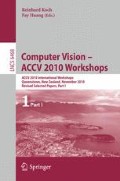Abstract
This paper addresses the problem of automatically learning common behaviors from long time observations of a scene of interest, with the purpose of classifying actions and, possibly, detecting anomalies. Unsupervised learning is used as an effective way to extract information from the scene with a very limited intervention of the user. The method we propose is rather general, but fits very naturally to a video-surveillance scenario, where the same environment is observed for a long time, usually from a distance. The experimental analysis is based on thousands of dynamic events acquired by three-weeks observations of a single-camera video-surveillance system installed in our department.
Access this chapter
Tax calculation will be finalised at checkout
Purchases are for personal use only
Preview
Unable to display preview. Download preview PDF.
References
Special issue on event analysis in videos. IEEE Trans on Circuits and Systems for Video Technology 18 (2008)
Pittore, M., Campani, M., Verri, A.: Learning to recognize visual dynamic events from examples. IJCV (2000)
Bashir, F., Khokhar, A., Schonfeld, D.: Object trajectory-based activity classification and recognition using hidden markov model. IEEE Trans. on IP 16 (2007)
Stauffer, C., Grimson, E.: Learning patterns of activity using real-time tracking. IEEE Transactions on PAMI 22 (2000)
Hu, W., Xiao, X., Fu, Z., Xie, D., Tan, T., Maybank, S.: A system for learning statistical motion patterns. IEEE Trans on PAMI 28 (2006)
Piciarelli, C., Micheloni, C., Foresti, G.L.: Trajectory-based anomalous event detection. IEEE Trans on Circuits and Systems for Video Technology 18 (2008)
Anjum, N., Cavallaro, A.: Multifeature object trajectory clustering for video analysis. IEEE Trans. on Circuits and Systems for Video Technology 18 (2008)
Hamid, R., Johnson, A., Batta, S., Bobick, A., Isbell, C., Colenam, G.: Detection and explanation of anomalous activities: representing activities as bags of event n-grams. In: Proc. CVPR (2005)
Jebara, T., Song, Y., Thadani, K.: Spectral clustering and embedding with hidden markov models. In: Kok, J.N., Koronacki, J., Lopez de Mantaras, R., Matwin, S., Mladenič, D., Skowron, A. (eds.) ECML 2007. LNCS (LNAI), vol. 4701, pp. 164–175. Springer, Heidelberg (2007)
Liao, T.W.: Clustering of time series data: A survey. Patt. Recogn. 38 (2005)
Niebles, J.C., Wang, H., Fei-Fei, L.: Unsupervised learning of human action categories using spatial-temporal words. In: Proc. of BMVC (2006)
Rieck, K., Laskov, P.: Linear-time computation of similarity measures for sequential data. JMLR 9, 23–48 (2008)
Morris, B., Trivedi, M.M.: Learning trajectory patterns by clustering: Experimental studies and comparative evaluation. In: Proc. CVPR (2009)
Ning, H., Xu, W., Chi, Y., Gong, Y., Huang, T.S.: Incremental spectral clustering by efficiently updating the eigen-system. Pattern Recogn. 43, 113–127 (2010)
Chi, Y., Song, X., Zhou, D., Hino, K., Tseng, B.L.: On evolutionary spectral clustering. ACM Trans. Knowl. Discov. Data 3, 1–30 (2009)
Halkidi, M., Batistakis, Y., Vazirgiannis, M.: On clustering validation techniques. Journal of Intelligent Information Systems 17, 107–145 (2001)
Günter, S., Bunke, H.: Validation indices for graph clustering. Pattern Recogn. Lett. 24, 1107–1113 (2003)
Noceti, N., Santoro, M., Odone, F.: String-based spectral clustering for understanding human behaviours. In: THEMIS-BMVC (2008)
Noceti, N., Odone, F.: Towards and unsupervised framework for behavior analysis. In: Proc. of AI*IA (PRAI*HBA) (2010)
Shi, J., Malik, J.: Normalized cuts and image segmentation. IEEE Trans. on PAMI 22, 888–905 (2000)
Taylor, J.S., Cristianini, N.: Kernel Methods for Pattern Analysis. Cambridge University Press, Cambridge (2004)
Angelova, A., Abu-Mostafa, Y., Perona, P.: Pruning training sets for learning of object categories. In: Proc CVPR (2005)
Grira, N., Crucianu, M., Boujemaa, N.: Unsupervised and semi-supervised clustering: a brief survey. In Muscle VIFP EU NoE (2005)
Author information
Authors and Affiliations
Editor information
Editors and Affiliations
Rights and permissions
Copyright information
© 2011 Springer-Verlag Berlin Heidelberg
About this paper
Cite this paper
Noceti, N., Odone, F. (2011). Unsupervised Video Surveillance. In: Koch, R., Huang, F. (eds) Computer Vision – ACCV 2010 Workshops. ACCV 2010. Lecture Notes in Computer Science, vol 6468. Springer, Berlin, Heidelberg. https://doi.org/10.1007/978-3-642-22822-3_9
Download citation
DOI: https://doi.org/10.1007/978-3-642-22822-3_9
Publisher Name: Springer, Berlin, Heidelberg
Print ISBN: 978-3-642-22821-6
Online ISBN: 978-3-642-22822-3
eBook Packages: Computer ScienceComputer Science (R0)

